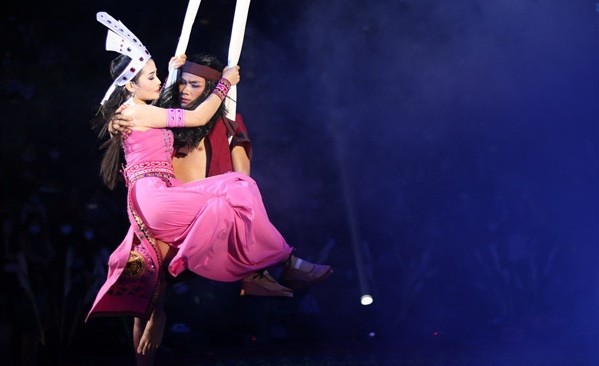‘The Magic Stick’ was staged thanks to the collaboration between the Vietnam Circus Federation and the Vietnam Cai Luong Theatre following an order by the Ministry of Culture, Sports and Tourism.
It is the first work within the two units’ joint art project entitled Huyen Su Viet (Vietnamese legendary history), which includes a total of four works praising the four immortals in traditional Vietnamese mythology – Tan Vien (the God of the Mountain), Saint Giong, Chu Dong Tu and the Mother Goddess Lieu Hanh.
This was also the first time that the two art forms were placed together, bringing a fresh and interesting experience to the audience.
‘The Magic Stick’ is the stage adaptation scripted by late renowned author Hoang Luyen and was inspired by the legend of the love between Chu Dong Tu and Princess Tien Dung.
It was directed by People’s Artist Trieu Trung Kien, Acting Director of the Vietnam Cai Luong Theatre, and People’s Artist Tong Toan Thang, Deputy Director of the Vietnam Circus Federation.
Soon after it’s launch a few months ago, the project drew great attention from art circles as everyone was curious about the blend of circus, which requires which and clear-cut movements, and ‘cai luong’, which has much slower pace.
However, it came to a nice surprise to the audience as the two art forms, which sound vastly different from each other, can mix and match well together. Of which, ‘cai luong’ helped to create the “spine” of the show while circus acts added a nice touch to the performance.
The audience was wowed to watch the spectacular swing act by the leading actor and actress when they first met and fell in love. The act sounded like a simple swing act in circus, but when it was integrated into a love story with a touching script, it won great applause from viewers.
The audience were also entertained with circus animal acts featured in the scene when the villagers offered animals to the newlywed couple.
 |
The artists’ performances were supported by lighting and sound system, which made the show even livelier for viewers.
The artists’ performances were supported by lighting and sound system, which created advanced visual and sound effects and made the show even livelier for viewers.
For the artists themselves, the show provided an opportunity to expand their capacity in an art form they hadn’t tried before, thus helping to enriching their performing skills.
Accordingly, cai luong singers who often perform on a box stage have had to learn to interact with the audience on a round stage at the circus. They also had to receive circus training for their performances.
Artist Minh Hai, who played the leading male role of Chu Dong Tu, said that it was an exceptional experience for him to sing cai luong melodies while flying in the air. It was his first time challenging himself with the round stage and trying such thrilling movements.
Hai recalled that he was a little bit nervous at first, but as he and Nhu Quynh, who played the leading female role of Tien Dung, were well instructed on the circus techniques, they grew tremendously excited.
Another appreciated bonus of the show was its music. Musician Dao Trung executed an excellent job in creating a nice fusion between cai luong melodies with other folklore tunes, jazz and even rap, thus helping the show win the hearts of young audience members.
‘The Magic Stick’ is an illustration of successful and elegant combination of cai luong and circus. It also suggests a new approach to renovating traditional art forms in order to create more interesting shows that can meet the increasing demands of theatre goers.
















